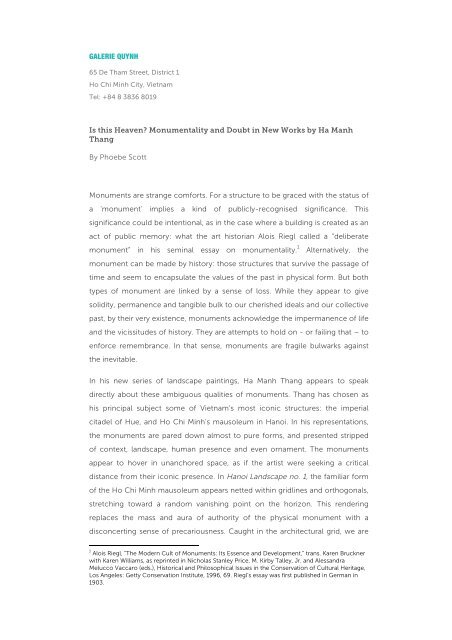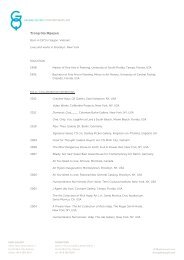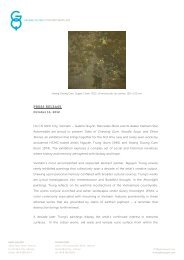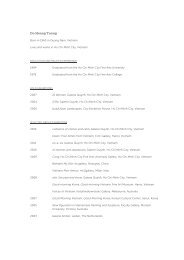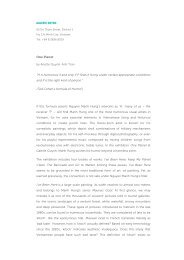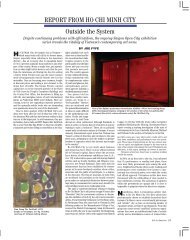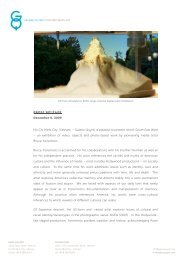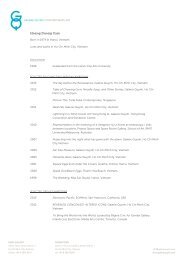by Phoebe Scott - Galerie Quynh
by Phoebe Scott - Galerie Quynh
by Phoebe Scott - Galerie Quynh
Create successful ePaper yourself
Turn your PDF publications into a flip-book with our unique Google optimized e-Paper software.
GALERIE QUYNH65 De Tham Street, District 1Ho Chi Minh City, VietnamTel: +84 8 3836 8019Is this Heaven? Monumentality and Doubt in New Works <strong>by</strong> Ha ManhThangBy <strong>Phoebe</strong> <strong>Scott</strong>Monuments are strange comforts. For a structure to be graced with the status ofa ‘monument’ implies a kind of publicly-recognised significance. Thissignificance could be intentional, as in the case where a building is created as anact of public memory: what the art historian Alois Riegl called a “deliberatemonument” in his seminal essay on monumentality. 1 Alternatively, themonument can be made <strong>by</strong> history: those structures that survive the passage oftime and seem to encapsulate the values of the past in physical form. But bothtypes of monument are linked <strong>by</strong> a sense of loss. While they appear to givesolidity, permanence and tangible bulk to our cherished ideals and our collectivepast, <strong>by</strong> their very existence, monuments acknowledge the impermanence of lifeand the vicissitudes of history. They are attempts to hold on - or failing that – toenforce remembrance. In that sense, monuments are fragile bulwarks againstthe inevitable.In his new series of landscape paintings, Ha Manh Thang appears to speakdirectly about these ambiguous qualities of monuments. Thang has chosen ashis principal subject some of Vietnam’s most iconic structures: the imperialcitadel of Hue, and Ho Chi Minh’s mausoleum in Hanoi. In his representations,the monuments are pared down almost to pure forms, and presented strippedof context, landscape, human presence and even ornament. The monumentsappear to hover in unanchored space, as if the artist were seeking a criticaldistance from their iconic presence. In Hanoi Landscape no. 1, the familiar formof the Ho Chi Minh mausoleum appears netted within gridlines and orthogonals,stretching toward a random vanishing point on the horizon. This renderingreplaces the mass and aura of authority of the physical monument with adisconcerting sense of precariousness. Caught in the architectural grid, we are1Alois Riegl, “The Modern Cult of Monuments: Its Essence and Development,” trans. Karen Brucknerwith Karen Williams, as reprinted in Nicholas Stanley Price, M. Kir<strong>by</strong> Talley, Jr. and AlessandraMelucco Vaccaro (eds.), Historical and Philosophical Issues in the Conservation of Cultural Heritage,Los Angeles: Getty Conservation Institute, 1996, 69. Riegl’s essay was first published in German in1903.
eminded that the monument was the end product of a human process ofdeliberation and construction, rather than an inevitable and eternal marker. HaManh Thang returns to the form of the mausoleum several times, yet each timeits image appears elusive, existing primarily as an outline, or perhaps atransparency. In one work, Thang has also included a phosphorescent underpaintingof the monument, visible only in darkness, when the structure glowsgreen, almost like a retinal afterimage. These repeated examinations seem tosuggest a kind of doubt: a relentless questioning of the monument, not just ofthe stability of its meaning, but even of its physical presence in the landscape.In these paintings, there are no reassuring historical narratives, nor is there anappeal to easy nostalgia through the picturesque. In some instances, thetreatment of the forms verges on stark. In Hue Citadel no. 3, the structure of thecitadel wall appears jutting and angular against a backdrop of hard, cool grey.The text emblazoned across the canvas – this is heaven – looks to have beenrepeatedly erased and re-inscribed, and betrays the confidence of the statementwith its hesitant and wavering quality. The reference to heaven could be areminder that the imperial city of Hue was carefully planned according to theprinciples of geomancy, with buildings, site and waterways organized to mostauspicious advantage inside the vast enclosure of the citadel walls. 2 The buildingof the new imperial city commenced shortly after the establishment of theNguyen dynasty in Hue in 1802. It was a symbol of the confidence of the newdynasty, and designed to ensure its longevity (including through practicalmeasures, such as the incorporation of new, French-style fortifications). Thearchitectural planning expressed a sense of order and harmony thatencompassed the relations of heaven and earth, and implied the emperor’sheaven-given mandate to rule.Yet before the close of that century, the cultural certainties of the Nguyendynasty were irrevocably shaken <strong>by</strong> the imposition of French colonial controlover Vietnam. Less than a century later again, the geomantic order of theimperial city was further marred <strong>by</strong> one of the most destructive battles of theVietnam War. Elements in this painting – the gunmetal grey, the drips of orangelike a faded bloodstain – could also be read as subtle references to that recenthistory. Hue’s imperial city was formally recognized as a World Heritage Site in1993, but in the passage from functional building to historical monument,something of its original confidence and ambition was necessarily lost. To lookat the citadel now is to look at the physical remnants of a system that has been2About the geomantic order of Hue’s imperial city, see Kerry Nguyen-Long, Arts of Vietnam 1009-1945, Hanoi: The Gioi Publishers, 2013, 182-183.
all but completely extinguished. Given this historical context, what claim to theeternal – to heaven – can the monument really make? Ha Manh Thang’spainting thus suggests the sceptical reverse of what it explicitly declares: is thisheaven?Could it be that monuments have a heightened significance in Vietnam, wherethe cultural paradigm shifts of the last century were particularly sweeping andradical? In the midst of such drastic revisions, what remains achieves a specialpoignancy. Ha Manh Thang has dealt with the theme of change in his paintingsbefore, especially the incommensurability of post-Doi Moi consumer culturewith the Vietnamese traditional values. In past series of work, such as Bride andBridegroom (2004-2012) and Not Memory (2008-2010), his approach was tojuxtapose the cultural symbols of past and present, creating an absurdist humourand pop-art aesthetic. Aspects of this approach linger in certain works in Heavenis a Place, especially where Thang has included the iconic structures ofcontemporary urban Vietnam. In Saigon Landscape no. 1, Bitexco FinancialTower appears at the vanishing point in the centre of a maelstrom of energy,while the landscape is filled with spectral buildings and anachronistic creatures,such as a Vietnamese beauty in the style of a traditional folk print. The worksuggests a city in which the undigested cultural past lingers awkwardly amidstrapid urban development. In general, however, in his new landscapes, Thang hasrejected the representation of the surface effects of change in favour of anintense focus on monumentality. When viewed together, these two types oflandscape paintings challenge us to imagine how the icons of today will becomethe monuments of the future. It is a kind of vanitas: the ruins of the past revealthe precariousness of the present, and our tenuous place in the world and intime.While Ha Manh Thang’s treatment of the monuments may be analytical, it is alsopainterly. He gives the monuments a forlorn allure. The layers of paint andconspicuous drips create a blurred effect, as if the monuments could not befully contained within the precision of the schematic drawings. For these works,Ha Manh Thang has also generated a personal and symbolic language of colour,partly inspired <strong>by</strong> the colours of Vietnamese traditional arts: the cobalt blue ofVietnamese blue and white porcelain, or the intense black of lacquer. For me,the melting, faintly-pearlescent blue green in Landscape of Hue Forbidden Cityno. 2is also strongly reminiscent of the celadon glazes of Vietnamese ceramics.These colours create subtle references and new associations with themonumental forms. At times, the use of colour can also be very unexpected,and functions to distance the monuments from their conventional historical
meanings. In several representations of the Ho Chi Minh mausoleum, forexample, the landscape is a saturated ultramarine, a disconcerting choice for abuilding which has such immediate associations with a certain shade of red. Inblue, the monument is oddly serene, and divorced from its own intenselyloadedhistory. But perhaps this act of decontextualisation – like the other formsof decontextualisation visible in these paintings – suggests a thread of optimismamidst the doubt. Monuments represent what is lost, but they can also be reimaginedand re-made. Their significance is not determined <strong>by</strong> the past: rather,they can be given new associations and meanings, to be woven into the present.April 2013


